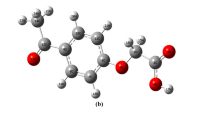Abstract
Density functional theory (DFT) was used to study the stereochemistry, thermodynamic stability, and spectra of recently synthesized bis-Betti base derivatives of 2,3-dihydroxynaphthalene obtained through multicomponent reactions of 2,3-dihydroxynaphthalene with aminoisoxazole and benzaldehyde derivatives. The stereochemistry of the products was investigated by theoretically calculating the infrared (IR) and proton nuclear magnetic resonance (1H NMR) spectra of the diastereomers and comparing them to the corresponding experimental data. The thermochemical properties of the reactions, including the enthalpy, internal energy, entropy, and Gibbs free energy, were also calculated. The diastereoselectivity of the reactions was estimated from the equilibrium distribution of diastereomers. According to the results, the synthesis of bis-Betti bases is exothermic and accompanied by a decrease in entropy. The energy difference between the diastereomers is quite small, but the Gibbs free energy change for the equilibrium syn \( \rightleftharpoons \) anti favors the anti over syn configuration. These results are in good agreement with experimental observations.

Calculated and experimental IR spectrum for bis-Betti base 2 (mixture of anti and syn configurations)







Similar content being viewed by others
References
Cardellicchio C, Capozzi MAM, Naso F (2010) The Betti base: the awakening of a sleeping beauty. Tetrahedron Asymm 21:507–517
Betti M (1900) On the addition of benzyl amine to naphthol. Gazz Chim Ital 30(I):301–309
Betti M (1900) General condensation reaction between β-naphthol, aldehydes and amines. Gazz Chim Ital 30(II):310–316
Betti M (1906) Cleavage/fission of the naphtholbenzylamine into its optical antipodes. Gazz Chim Ital 36(II):392–394
Shen AY, Tsai CT, Chen CL (1999) Synthesis and cardiovascular evaluation of N-substituted 1-aminomethyl-2-naphthols. Eur J Med Chem 34:877–882
Cimarelli C, Palmieri G, Volpini E (2002) A practical stereoselective synthesis of secondary and tertiary aminonaphthols: chiral ligands for enantioselective catalysts in the addition of diethylzinc to benzaldehyde. Tetrahedron Asymm 13:2417–2426
Feng J, Dastgir S, Li C-J (2008) Synthesis of a new type of chiral N, P- and N, O-ligands. Tetrahedron Lett 49:668–671
Shafiee M, Khosropour AR, Mohammadpoor-Baltork I, Moghadam M, Tangestaninejad S, Mirkhani V (2012) An efficient, expeditious, and diastereoselective one-pot pseudo-fivecomponent reaction for the synthesis of new bis-Betti bases under catalyst-free conditions. Tetrahedron Lett 53:3086–3090
Xiong R-G (2008) One-pot preparation of bis-Betti base product. Lett Org Chem 5:265–268
Zamani M, Shafiee M, Keshavarz MH (2014) IR, 1H NMR and DFT studies of novel bis-Betti base derivatives of 2,6-dihydroxynaphthalene: thermodynamic control of diastereoselectivity and configurational preference. J Mol Struc 1075:139–146
Zhao Y, Truhlar DG (2008) The M06 suite of density functionals for main group thermochemistry, thermochemical kinetics, noncovalent interactions, excited states, and transition elements: two new functionals and systematic testing of four M06-class functionals and 12 other functionals. Theor Chem Acc 120:215–241
Sinnecker S, Rajendran A, Klamt A, Diedenhofen M, Neese F (2006) Calculation of solvent shifts on electronic G-tensors with the conductor-like screening model (COSMO) and its self-consistent generalization to real solvents (COSMO-RS). J Phys Chem A 110:2235–2245
Curtiss LA, Redfern PC, Raghavachari K, Rassolov V, Pople JA (1999) Gaussian-3 theory using reduced Møller–Plesset order. J Chem Phys 110:4703–4709
NIST (2015) NIST Chemistry Web Book: NIST Standard Reference Data Base Number 69. :http://webbook.nist.gov/chemistry/ (references for individual molecules are given therein)
London F (1937) The quantic theory of inter-atomic currents in aromatic combinations. J Phys Radium 8:397–409
Ditchfield R (1974) Self-consistent perturbation theory of diamagnetism. 1. Gauge-invariant LCAO method for N.M.R. chemical shifts. Mol Phys 27:789–807
Neese F (2012) The ORCA program system. WIREs Comput Mol Sci 2:73–78
Schmidt MW, Baldridge KK, Boatz JA, Elbert ST, Gordon MS, Jensen JH, Koseki S, Matsunaga N, Nguyen KA, Su SJ, Windus TL, Dupuis M, Montgomery JA (1993) General atomic and molecular electronic structure system. J Comput Chem 14:1347–1363
Bachrach SM (2007) Computational organic chemistry. Wiley, Hoboken
Pavia DL, Lampman GM, Kriz GS, Vyvyan JR (2009) Introduction to spectroscopy. Brooks Cole, Belmont
Acknowledgment
The corresponding author would like to thank the research council of Damghan University for supporting this work.
Author information
Authors and Affiliations
Corresponding author
Rights and permissions
About this article
Cite this article
Zamani, M., Shafiee, M. & Keshavarz, M.H. Stereochemistry and spectroscopic analysis of bis-Betti base derivatives of 2,3-dihydroxynaphthalene. J Mol Model 22, 86 (2016). https://doi.org/10.1007/s00894-016-2936-x
Received:
Accepted:
Published:
DOI: https://doi.org/10.1007/s00894-016-2936-x




